The Samsung Galaxy S7 and S7 edge Review: Part 2
by Joshua Ho on July 5, 2016 8:00 AM EST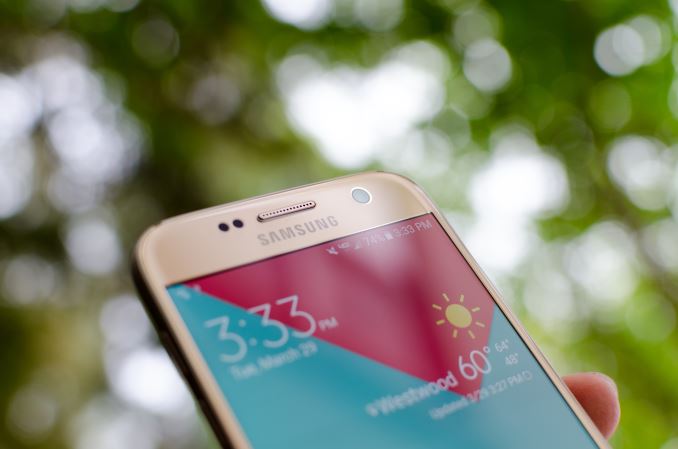
With part one of our Galaxy S7 review, it was clear that the Galaxy S7 was at least a mild improvement to the Galaxy S6 in some ways, but there were still many areas to investigate. At the time, we were in the middle of transitioning to our new 2016 benchmark suite, which meant that it was necessary to re-test the Galaxy S7.
Our 2016 benchmark suite attempts to really push our testing in general to a new level of depth and more importantly, more focused on the overall user experience. When reflecting upon the value of AnandTech from a testing perspective, it’s clear to me that while part of our value is running benchmarks across a wide range of phones, another part of our value is being able to run tests that others wouldn’t be able to run at all.
With our new test suite for 2016, our extended suite of benchmarks attempts to focus on the latter to go deeper in reviews in a meaningful way. I definitely enjoy examining architectural details through microbenchmarks, but for general reviews our standard test workflow needed to be focused on user experience in a deeper way. With this in mind, we can get into the data that we were missing with part 1 of the review. Of course, if you haven’t read part 1 of the Galaxy S7 review, I highly recommend reading it first just to get a better introduction into the basics of the Galaxy S7.
Battery Life
Of course, now that we have our full suite of benchmarks we can start to look over in detail how devices perform. While we’ve gone over some of the results before it’s probably fair to say that our discussion of battery life on the Galaxy S7 was woefully incomplete with part 1 of the review. It’s also worth noting that internally we were still working on our 2016 web browsing test at the time so it wasn’t necessarily complete and sufficiently consistent and accurate. In the time since, we’ve been able to get all of the bugs ironed out and get a test that provides useful data that our previous tests didn’t.
As battery life is a critical part of our testing, it’s important for us to get this right, and in order to get useful relative comparisons we have to make sure that every device is tested in the same manner to avoid bias in one way or another. In order to achieve this, all devices have all possible background services disabled, as well as sync and automatic app updates. In order to try and make an even comparison we also set the display to 200 nits brightness on a 100% average picture level display, also known as a blank white screen. However, one area that we aren’t necessarily able to control for 100% of the time is ambient temperature, device orientation, or material contact. While tests that don’t reach TDP limits won’t see any effects, TDP-limited tests will see a delta here, but it’s hard to estimate just how much of an impact exists here.
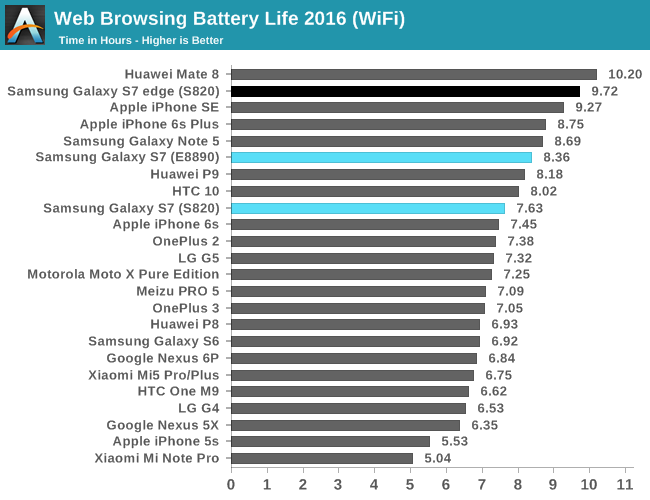
With this baseline in mind we can move on to the actual results. As seen in the chart above for WiFi web browsing on our new test it’s worth mentioning that the data here has changed as changes to the test have affected results, generally bringing battery life down or keeping it around the same. The Galaxy S7 does fairly respectably here, although the Snapdragon 820 version is definitely showing either architectural or implementation inefficiency here when compared to the Exynos 8890. A delta of about 10% means that the Exynos 8890 GS7 uses about 1.38W average here while the Snapdragon 820 GS7 uses about 1.51W in this test assuming that the battery capacity is nominal. If you subtract out an estimated display power the delta that can be attributed to non-display factors is something like 30% here. Interestingly, the HTC 10 is mildly more efficient here with its higher density LCD, with the AMOLED display consuming something like 10% more power despite the presence of dark-themed webpages to try and bring some balance here. The Galaxy S7 edge is pretty much the top here, but achieves its battery life through sheer battery size rather than efficiency.
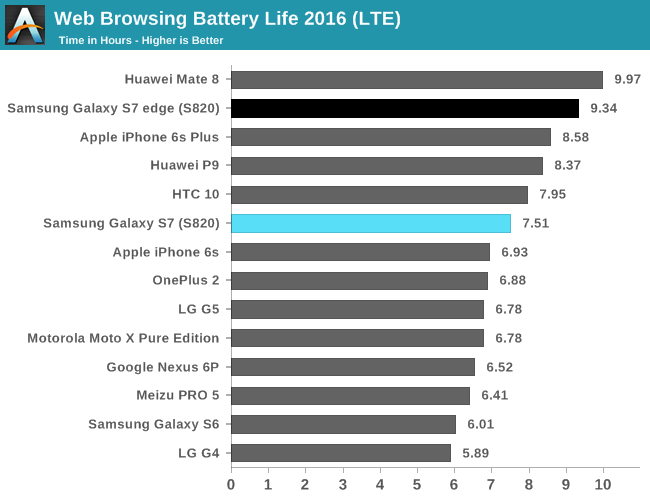
Moving on to LTE we can really start to see the battery life advantage that the Snapdragon 820 brings. It turns out that as a communications company, Qualcomm is good at making radios. One of the most obvious ways that this shows is in power, as the Snapdragon 820 basically has the same battery life whether you’re on LTE or WiFi, which isn’t necessarily the case with other devices. Unfortunately, we haven’t been able to test the Galaxy S7 with Exynos 8890 in comparable conditions for LTE so we can’t really see how power of the S820 modem compares with the Exynos’ Shannon modem, but we continue to see that the Galaxy S7 S820 is a bit behind the HTC 10 in battery life due to the use of an AMOLED display in high-APL workloads. However, the difference is nowhere near what it was in the past, and is close enough to not really make a huge difference. The Galaxy S7 edge performs well here, but on the basis of its battery size rather than efficiency.
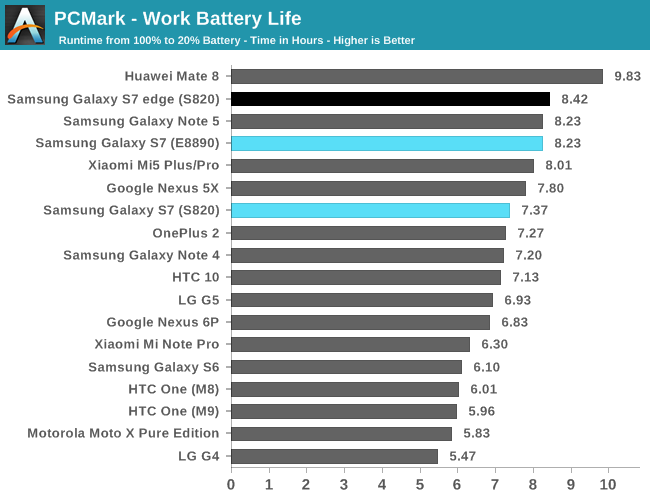
In the interest of not just relying on our own web browsing tests to try and get a handle for what battery life is like in general purpose compute situations, we continue to use PCMark’s battery life test to see how performance is in a benchmark that doesn’t attempt to equalize the amount of work done per unit time. Here the Galaxy S7 actually seems to be a fair bit better than the HTC 10, but this is likely due to the previously mentioned binning differences and some differences in governor as the delta in power and performance isn’t really all that much. The Galaxy S7 edge extends the lead here, again mostly due to the larger battery as the two devices are generally quite similar to each other.
Moving on to throttling performance we’ve transitioned to GFXBench’s Manhattan test on infinite rundown instead of T-Rex for this year as some devices from certain vendors have a tendency of reaching vsync on T-Rex which meant that it was difficult to see just how much throttling occurred over the duration of the test. After some testing it’s evident that for the most part throttling behavior is not necessarily changed by Manhattan either, so there’s not much need to retain T-Rex for high-TDP tests. Basemark OS II’s battery life testing is also rather questionable at this point, so we will no longer be reporting these scores as the methodology isn’t up to par with our expectations for 2016 and beyond.
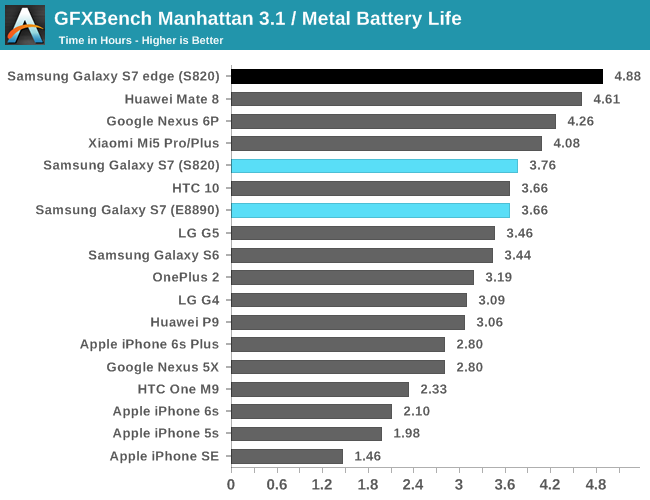

In the case of Manhattan, we continue to see some of the sinusoidal behavior seen in T-Rex throttling as it seems that Samsung’s throttling algorithms tend towards a more underdamped behavior than critically damped like HTC’s. However, for whatever reason it looks like the Galaxy S7 edge ends up with similar oscillating throttling behavior. Interestingly enough, even though the Galaxy S7 spends more time at higher performance states than the HTC 10, it manages to last longer, which is likely due to the lower APL of this content in conjunction with forced power save modes, and higher sustainable skin temperatures due to the glass back with heatpipe cooling to help distribute heat. Of course, the Galaxy S7 edge manages to last longer than either due to its larger size and battery.
Overall, the Galaxy S7 has decent battery life, while the S7 edge has great battery life due to its relatively large battery compared to its display size. The improvements here aren’t necessarily going to blow you away unless you get the Exynos 8890 variant, but it’s good to see that we’re finally back to improving on battery life with the launch of the Snapdragon 820 compared to the Snapdragon 810 and 808’s rather disappointing power efficiency due to the use of a high-power implementation and process node. I’m not sure the Snapdragon 820 is really the best design we’ve seen on 14LPP when it's more on par with 14LPE SoCs for efficiency, but it’s good enough that it doesn’t fundamentally compromise a device.


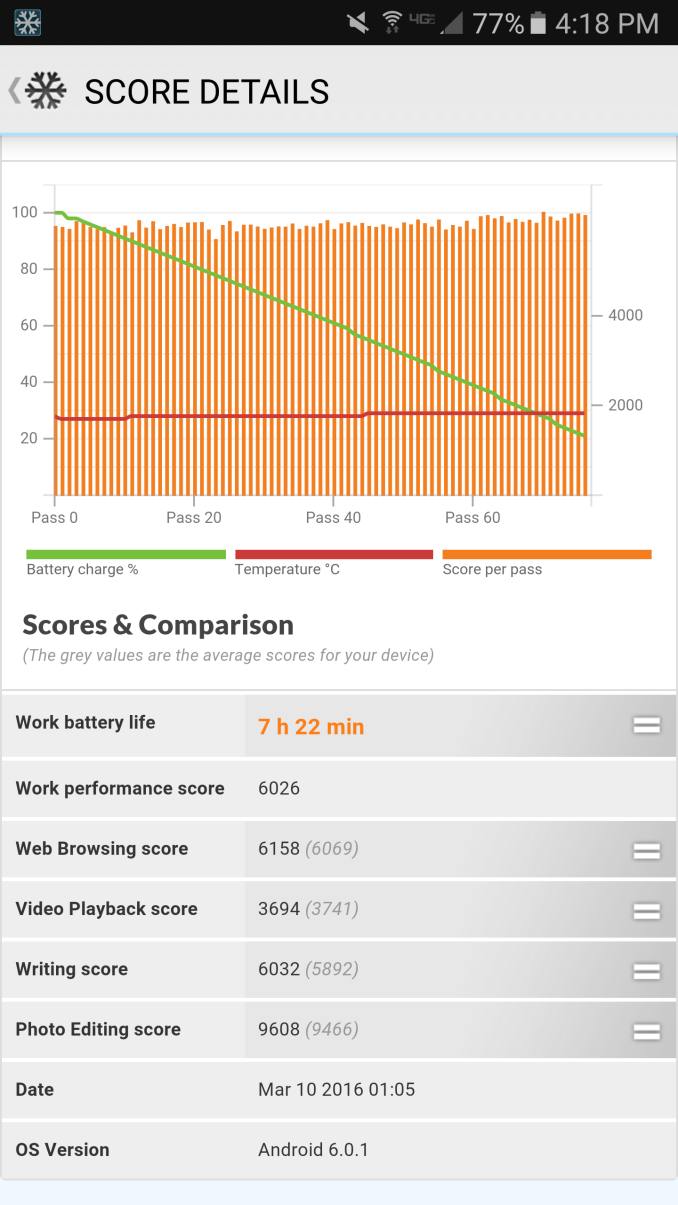
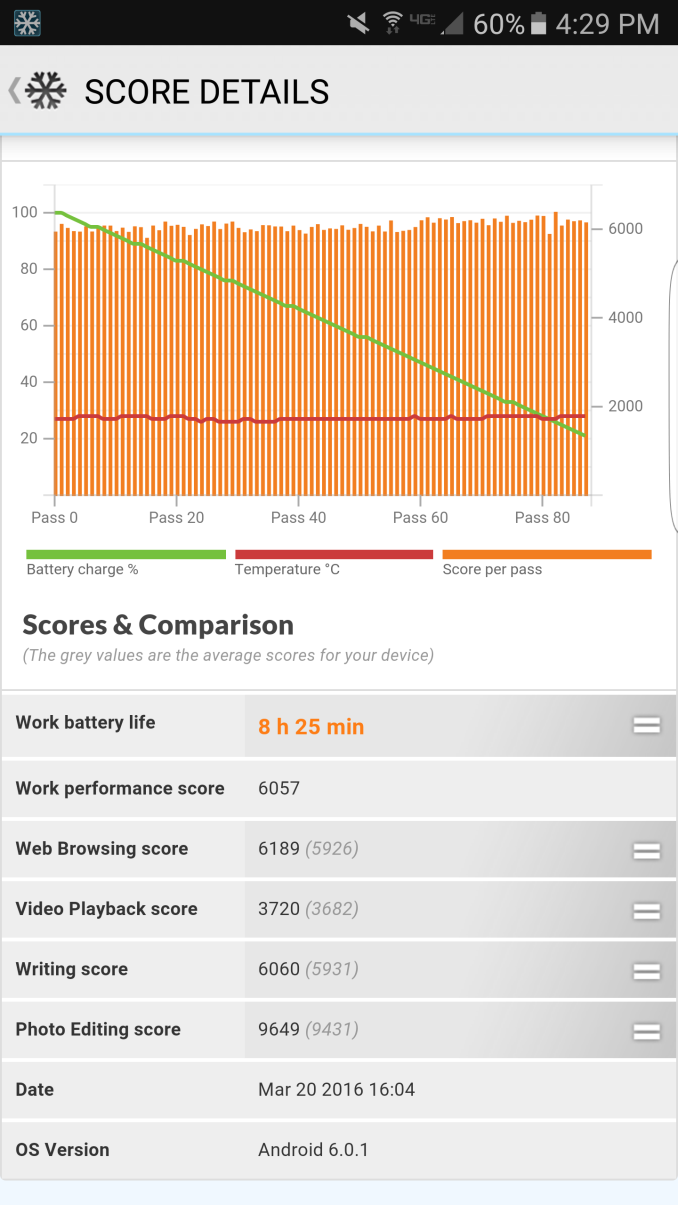
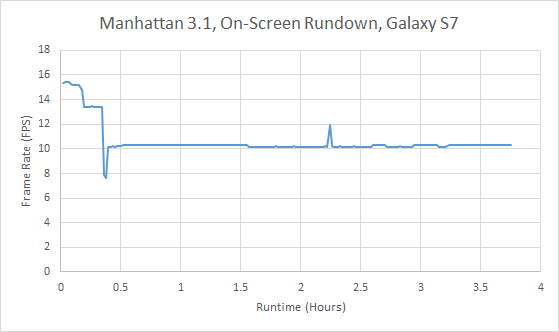
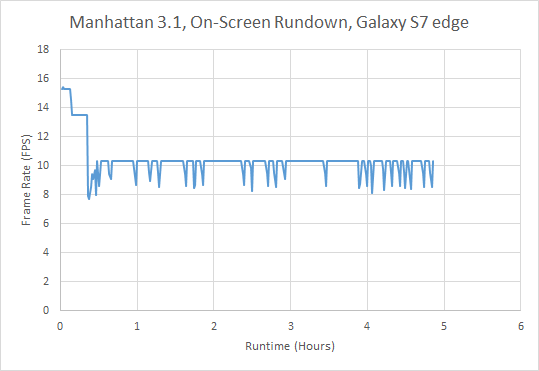








266 Comments
View All Comments
ray_cheeno - Sunday, July 10, 2016 - link
Dear Joshua, it's very fine that you point out that the Samsung S7 too expensive compared to One plus 3 and Xaomi Mi5. I have not seen a comment to your favored Apple IPhone 6 and 6S. Therefore I would like to see a Part 3 and more objectivity. Thank you.Lau_Tech - Sunday, July 10, 2016 - link
I feel that going forward Josh should do the Iphone reviews and Andrei should do the Android phone ones.I don't doubt the objectivity of either writer, but Josh's tendency to downplay and undersell android phones and features, as well as to produce late reviews, has undoubtedly contributed to Anandtech's reputation as an pro Apple site.
Splitting up the phones (perhaps android phones require 2 writers, given their volume) will allow for faster and greater variety in reviews.
Ranger1065 - Tuesday, July 12, 2016 - link
Now taking bets on whether Anandtech will have a proper Geforce 1080 review within 6 months of release...My bet is NOT.
Even if they do who will care?
As the clicks decrease....
Bye Bye Anandtech.
_Aaron_ - Tuesday, July 12, 2016 - link
--- Anandtech Galaxy S7 Review: "Although the G5 seems to have started an AF run in the middle of the capture, the areas where the photo is actually focused are arguably better than what the Galaxy S7 can put out. Even next to the G4, the Galaxy S7 falls short. I’m honestly not sure why LG doesn’t get more credit here, because next to Apple they seem to have the best image processing algorithms in the industry.Unfortunately, the Galaxy S7 is just a bit disappointing here. The LG G5 is just clearly better here as noise reduction is better in pretty much every way and it looks a lot more natural due to less obvious sharpening halos. I would also argue that the HTC 10 is also better here due to its better texture detail and better handling of shadow detail, even if edges are softer.
However, with that said the output of the Galaxy S7 and S7 edge’s camera is not that impressive. I would argue that while it’s not worse than the iPhone 6s Plus, it is basically comparable. The real competition in this space comes from the HTC 10 and LG G5, the two of which manage to deliver arguably better still image output ".
--- Anandtech LG G5 review: " When it comes to noise in bright outdoor conditions, the G5 sits about in the middle of this pack the G5 sits about mid pack, with the iPhone 6s Plus, Huawei P9, and Galaxy S7 edge all performing just a little better.
In both scenes, the Galaxy S7 edge takes the brightest picture despite using the fastest shutter speed. The G5’s images are a little darker than the G4’s because it favors a shorter exposure, but it still produces brighter images than the Moto X and Nexus 6P.
The Galaxy S7 edge shows no vignetting, while the Nexus 6P suffers from this issue to a mild degree. All of the other phones, including both of the G5’s cameras, show negligible vignetting.
In bright daylight, the G5 equals the Galaxy S7 edge, producing excellent looking photos. When there’s less light available, like on cloudy days or when moving indoors, the G5 starts to struggle. It still does pretty well setting white balance and exposure, although the iPhone 6s Plus consistently does better. Image noise, however, is a serious problem for the G5. Its images show significantly more noise grain than other flagship devices, degrading image quality ".
Ok, now, I'm confused: should I follow Anandtech's words, or Anandtech's words?
isik - Tuesday, July 12, 2016 - link
www.egemenweb.com thankspeterApinto - Tuesday, July 12, 2016 - link
The whole review spells "NOT BIASED!" in every part.Why? Because the author is actually able to document his allegations, transforming them into arguments.
In fact, this review is really close to being an actual analysis, where the author breaks down all the relevant parts of the S7 and its functions, in order to produce a solid evaluation. And he does this by using solid test tools and techniques, so the results can be recreated by others. This is as close to science as I imagine any tech site is able to get.
So - you can disagree on his conclusion, but calling this review biased just shows that it is you who is biased. Really.
KoolAidMan1 - Thursday, July 14, 2016 - link
Reality is biased for emotional ideologues who worship Android as their god.IDGI
StimulatedBoy - Wednesday, July 13, 2016 - link
Thx, Joshua. This kind of analyses, eye for details and objectivity is what has drawn me to Anandtech for the last 10-15 years. Keep up the good work!Aaight - Thursday, July 14, 2016 - link
Lol, er du her og grupperunker også :D Synd du bommet på 3 av 3, hehe!pukemon1976 - Wednesday, July 13, 2016 - link
I see the comments mention bias a lot. Me? I think the author is trying to get a job at apple like Klug and Shimpi. Geez. Can you not make it anymore obvious? I think some of us that are fanboys of android pretty much know that apple makes a good all around overpriced phone. Cpu? Winner by efficiency and architecture. GPU? Not necessarily winner but powerVR uses different method of drawing graphics and that is drawing what is only shown. Nonetheless, powerVR makes a damn good efficient GPU. A lot of things are just details. Like battery life? Author gets away with mentioning but x phone has a bigger battery. What about iPhone uses less lines of resolution in both their models so battery life comparison is just details. Cameras? I can't comment really on quality of s7/s7 edge but do know they focus really fast and process fast. Especially exynos version. Iphone camera? I've seen some really.bad pictures from my friends as of late. And some admittedly know their camera isn't all it's cracked up to be. If I'm taking pictures with my note4 at some memorable event usually my friends and family want copies of my pictures, no matter what phones they have. And work just issued us iPhone 6+ a few months ago. Geez. Impressed with sunny day shots. But I work in dark environments often. I'm pulling out my note4 camera or somebody is asking me to take an important picture if only iphones around most of the time. And I wish author and company would take a better approach to wifi and lte battery tests. My note4 with the first modem to use power enveloping for LTE is noticeablyore efficient than WiFi. I've proven it over and over and over. Even my geek friends are befuddled by it. And how come author never mentions iPhone dropping frames or lagging? I do admit though iPhone does have great memory management, not to mention noticeably faster internal storage. My micro SD though... oh wait... have to pay super premium for extra storage. Really wish author and friends were less biased. I'm fine with opinions. Anand wrote great articles and his iPhone bias didn't ruin it for me. Methinks, the reviews take so long because anandtech isn't anandtech anymore. Me also thinks author and friends so jealous they meticulously spend a ridiculous amount of time making apple proud of their review so they too can go work in Cupertino one day. Unbelievable how shoddy this review was. Really? When you couldn't say apple was the best bar none in a certain department you digressed to other Android phones, probably meaning apple isn't even close to the top, since you have to resort to that. And some of you apple fanboys need to lay off the apple look aid. It has been so obvious as of late. I know apple does a lot of things well. And some they don't. And then there's so much customization in amdroid, especially with root, even moreso with unlocked bootloader. I think some of you guys never read Klug's and shimpi's reviews. Even though they showed their apple bias, they did some really good reviews. Reviews I would come back for. Even read the iphone reviews. I know why I've hardly been coming to anandtech lately but this review I know I'll be coming even less. No more bookmarks or waiting g for the other stuff l liked to read about like Intel, nvidia, and, ssd tech. Until next time, might be awhile, and hopefully better reviewers, peace out.